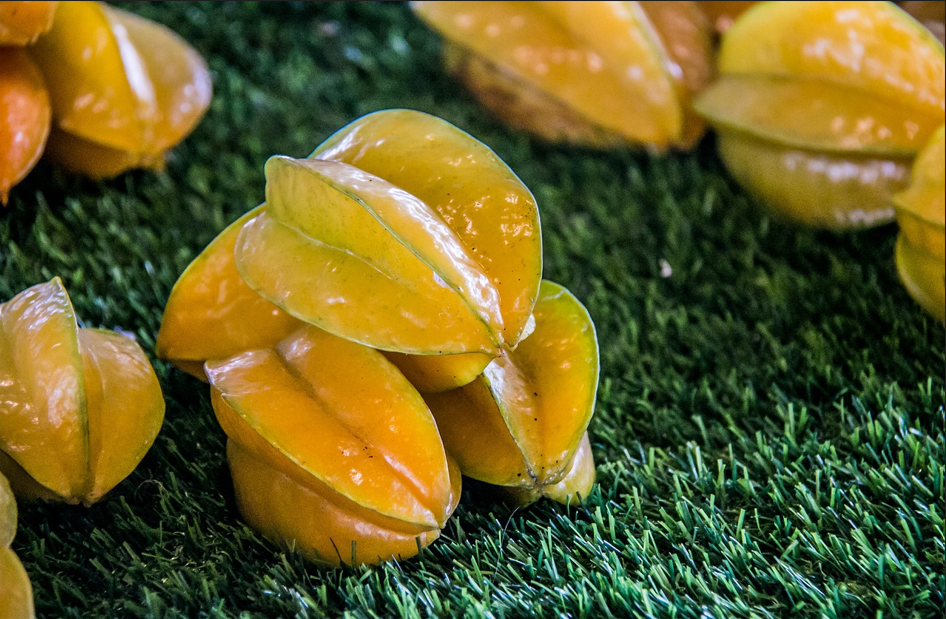Star fruit, scientifically known as Averrhoa carambola, is a tropical fruit that stands out due to its distinctive star-shaped cross-section when sliced. This intriguing fruit is not only aesthetically appealing but also offers a wide range of health benefits, making it a popular choice among health-conscious individuals. Below, we will explore what star fruit is, its origin, global distribution, abundance, and its health benefits.
What is Star Fruit?
Star fruit is a small to medium-sized tropical fruit that
comes from a tree of the Averrhoaceae family. The fruit is elongated,
typically between 5 to 15 centimeters (2 to 6 inches) in length, and has five
distinct ridges along its sides. When sliced crosswise, the fruit forms a
unique star-shaped pattern, hence its name. The fruit's skin is waxy and thin,
and its flesh is crisp and juicy with a flavor that can range from mildly sweet
to tart, depending on its ripeness.
Star fruit can be eaten raw, added to fruit salads, or used
in cooking and beverages. It is known for its refreshing flavor, which combines
hints of apple, citrus, and grape. The fruit can be enjoyed with or without its
skin and contains small, edible seeds.
Where Does Star Fruit Come From?
Star fruit is native to Southeast Asia, specifically the
Philippines, Indonesia, and Malaysia. It has been cultivated for centuries in
these regions due to its tropical climate and favorable growing conditions. The
fruit was introduced to other parts of the world by trade and exploration, with
its cultivation spreading to regions with similar climates.
Today, star fruit is grown in various tropical and
subtropical regions around the globe.
Where is Star Fruit Found?
Star fruit is found in many tropical and subtropical
regions, particularly in Asia, Central America, and parts of the Caribbean.
Countries that cultivate star fruit include:
- Southeast
Asia: Thailand, the Philippines, Malaysia, and Indonesia are among the
primary regions where star fruit is cultivated.
- India:
Star fruit is grown extensively in southern and western parts of India.
- Central
America: Countries like Costa Rica, Honduras, and Guatemala have
suitable conditions for growing star fruit.
- The
Caribbean: The fruit is also grown in tropical islands like the
Dominican Republic and Puerto Rico.
- United
States: In the U.S., star fruit is mainly grown in Florida,
California, and Hawaii, where the tropical climate allows for optimal
growth.
Where is Star Fruit Most Abundant?
Star fruit thrives in warm climates and is most abundant in
Southeast Asia and tropical regions where it is cultivated year-round. The
Philippines, Malaysia, and Indonesia remain the largest producers and exporters
of star fruit due to their ideal growing conditions. Additionally, star fruit
is commonly available in Central and South American markets, where it is grown
for both local consumption and export.
As a tropical fruit, star fruit is typically harvested from
late spring to early winter. However, the availability of the fruit may vary
depending on local climates and growing seasons.
What are the Health Benefits of Star Fruit?
Star fruit is not only a delicious and refreshing snack but
also a powerhouse of essential nutrients. It offers several health benefits due
to its rich content of vitamins, minerals, and antioxidants:
- Rich
in Vitamin C: Star fruit is an excellent source of vitamin C, an
antioxidant that helps boost the immune system, promotes collagen
production for healthy skin, and protects the body from free radicals.
- Low
in Calories: Star fruit is naturally low in calories, making it an
ideal choice for those looking to maintain a healthy weight or reduce
calorie intake while still enjoying a tasty fruit.
- High
in Fiber: The fruit is a good source of dietary fiber, which aids in
digestion, helps maintain healthy cholesterol levels, and promotes
feelings of fullness, making it beneficial for weight management.
- Promotes
Heart Health: Star fruit contains potassium, which is essential for
maintaining healthy blood pressure levels. The high fiber content also
supports heart health by reducing the risk of cardiovascular diseases.
- Rich
in Antioxidants: Star fruit contains various antioxidants, including
flavonoids and polyphenols, that help combat oxidative stress, reduce
inflammation, and support overall health.
- Supports
Skin Health: Due to its vitamin C content, star fruit is beneficial
for skin health, promoting collagen production and preventing premature
aging. It is also commonly used in skin-care products for its hydrating
and soothing properties.
- Aids
in Hydration: Star fruit has a high water content, making it a natural
way to stay hydrated, especially in hot climates or after physical
activity.
Caution: Risks and Precautions
While star fruit is nutritious, it is important to note that
it can pose health risks for individuals with kidney issues. Star fruit
contains a neurotoxin called caramboxin, which may cause neurological
symptoms in people with kidney disease. These symptoms can include nausea,
vomiting, confusion, and in severe cases, seizures. People with kidney problems
are advised to avoid consuming star fruit or consult with a healthcare
professional before doing so.
Conclusion
Star fruit is an exotic and versatile tropical fruit that
offers a variety of health benefits. Native to Southeast Asia, it has gained
popularity around the world for its unique flavor and nutritional value. Packed
with vitamin C, fiber, antioxidants, and other essential nutrients, star fruit
is a delicious addition to any diet, supporting immune health, heart health,
skin health, and more. Whether enjoyed fresh, in smoothies, or in savory
dishes, star fruit is a nutritious and refreshing treat that can easily become
a staple in many households.
By understanding its origins, cultivation, and health
benefits, it is clear that star fruit is not just a visually captivating fruit
but a nutritious powerhouse that deserves a place in a healthy, balanced diet.
References:
- "Starfruit:
Benefits, Side Effects, and How to Eat." Healthline,
https://www.healthline.com/nutrition/starfruit#nutrition
- "Averrhoa
carambola." Wikipedia, https://en.wikipedia.org/wiki/Averrhoa_carambola
- "Star
Fruit." Medical News Today,
https://www.medicalnewstoday.com/articles/star-fruit






